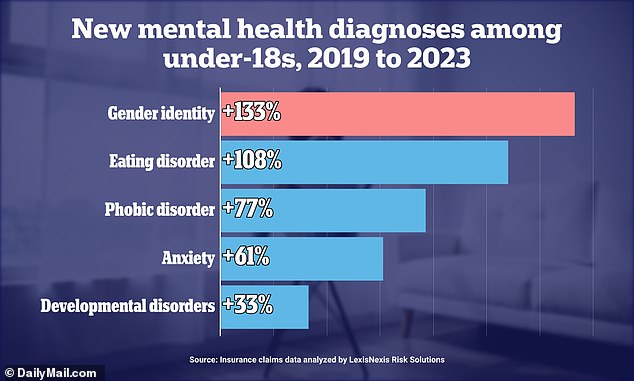A report suggests that children and adolescents are diagnosed with gender dysphoria at twice the rate today than before the pandemic.
Analysts at LexisNexis, which tracks 300 million patients, found that the number of insurance claims for gender identity care among those under 18 increased 133 percent between 2019 and 2023.
It is part of a broader sharp rise in mental health problems among children.
Claims for care related to Eating disorders increased 108 percent at the same time, while anxiety-related claims increased 61 percent.
Overall, the report found that requests for any type of mental health care increased by 83 percent among those under 18 during the period studied.
The above shows insurance claims for mental health care, according to LexisNexis. They analyzed data from more than 300 million patients

There are increases in the number of young people reporting gender dysphoria, or when their gender does not match their biological sex.
Many experts have attributed the increase in cases of gender dysphoria to greater acceptance of gender dysphoria and a greater willingness to seek treatment.
But there is also concern that children’s impressionable minds are easily influenced by social trends.
Much of the increase was also recorded during the Covid pandemic, with commentators suggesting that isolation due to lockdowns and increased online social interaction could have led to introspection or doubt among children about their gender identity. .
The report was compiled by LexisNexis Risk Solutions, a New York City-based data company that tracks billions of claims made in the United States each year.
Their claims for gender identity care may have included counseling sessions and appointments to obtain prescriptions for gender-affirming treatments.
No data was published on the number of applications filed based on gender identity among children under 18 years of age per year.
But the report coincides with similar studies that have also noted an increase in attention to transgender people.

The above shows insurance claims for diagnoses of gender dysphoria (or a gender other than assigned at birth) by year. These have also doubled since 2017.

Across all age groups, surgery rates increased more dramatically in 2021

A study published in 2022 found that the number of ‘major’ surgeries (where the breasts are removed) performed on under-18s had increased 13-fold since 2013, while a second from a data analytics company said Some states had seen up to a 274 percent increase in gender dysphoria rates from 2018 to 2022.
Gender dysphoria occurs when someone says that their biological sex does not match their gender identity.
It is diagnosed through an interview with a mental health professional, who can then prescribe treatments.
These may include counseling, as well as taking therapies such as puberty blockers and feminizing or masculinizing hormones.
Gender-affirming surgeries may also be offered to make a person’s body better match their gender identity.
Dr. Abbey Jo Schrage, an Idaho-based psychotherapist who treats transgender children, said Fox News that the increase was likely driven by increased awareness.
“The first is the simple fact of awareness around gender identity issues,” she told the publication.
“Young people have constant new access to information and language about topics such as gender identity through countless apps and websites.”
And he added: “Another factor is the growing cultural and social acceptance of expressions related to gender identity.”


